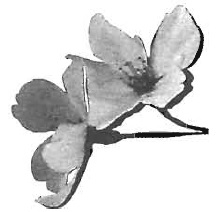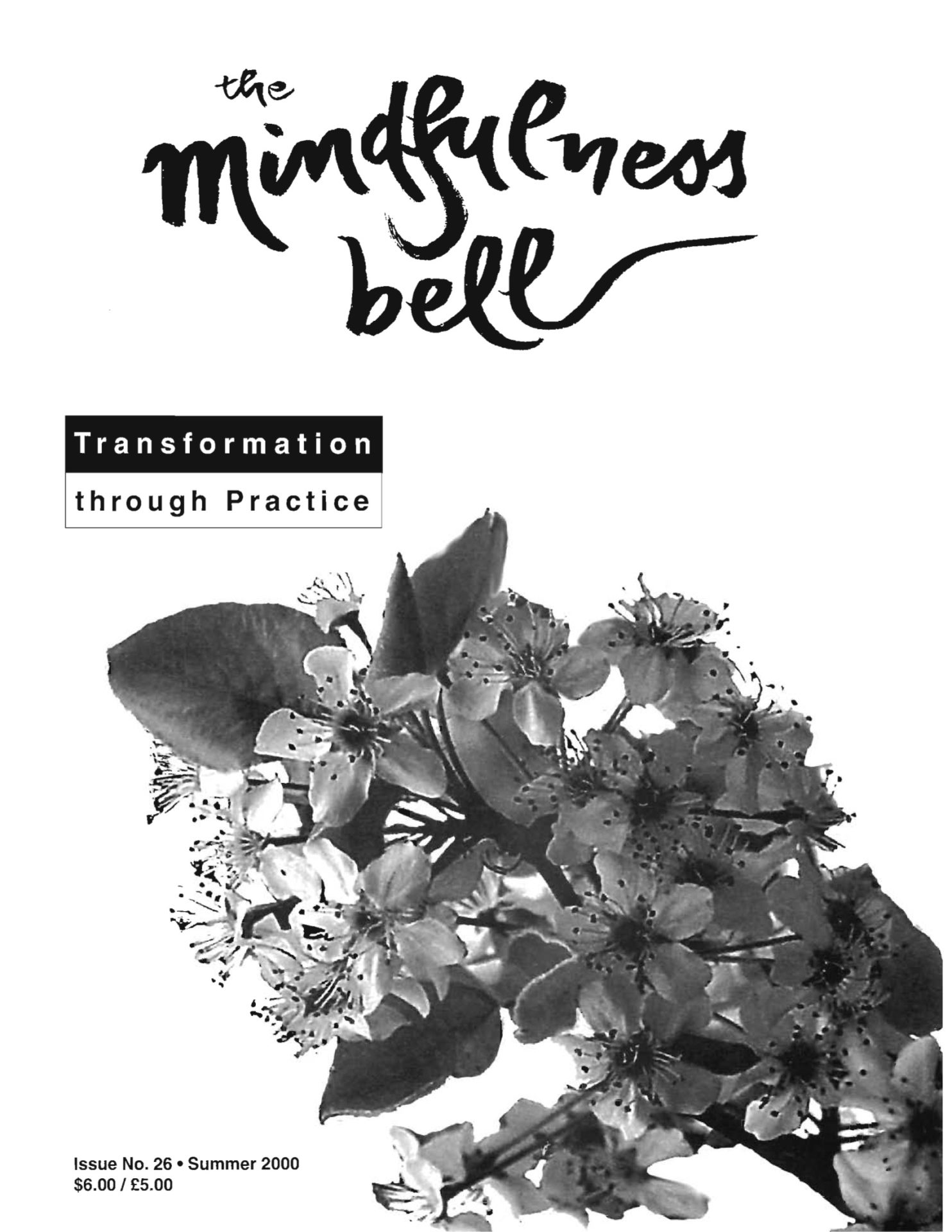By Bill Menza
On October 16, 1999, for the first time ever, the state of Maryland opened its prison doors to a renowned Buddhist Zen master. The Venerable Thich Nhat Hanh rode in the second of two cars caravaning from Washington, D.C. to the medium security prison at Hagerstown, Maryland. The glorious autumn day reflected the importance of the event, making the one-and-a-half hour trip seem as wondrous as the leaves falling from the passing trees.
A few months before,
By Bill Menza
On October 16, 1999, for the first time ever, the state of Maryland opened its prison doors to a renowned Buddhist Zen master. The Venerable Thich Nhat Hanh rode in the second of two cars caravaning from Washington, D.C. to the medium security prison at Hagerstown, Maryland. The glorious autumn day reflected the importance of the event, making the one-and-a-half hour trip seem as wondrous as the leaves falling from the passing trees.
A few months before, Emma Lou Davis, who chairs the Community Correctional Services Committee of Washington County, Inc. (CCSC), a nonprofit group of volunteers who support prison inmates, had read some of Thay's books. A few weeks later, Bo Lozoff, Director of the Human Kindness Foundation, called to see if she could arrange Thay's visit to the prison. Bo and Sita, his wife and Foundation codirector, have worked for more than 25 years to bring spiritual support to people in prisons. They have visited over 600 prisons to teach a way of life based upon three common principles taught by the great sages of all religions: simple living, dedication to service, and commitment to personal spiritual practice. The foundation and CCSC also work with the American Friends' Alternatives to Violence Project, which teaches prisoners how to turn away from violence and toward responsible nonviolent ways of handling conflict and living.
Hagerstown, Maryland is a rural area with many farms and beautiful landscapes. Signs to the correctional facilities brought us to a small gravel road that ends at three prisons set in rolling fields: the Maryland Correction Institution at Hagerstown (MCI), the Roxbury Correctional Institution, and the Maryland Correctional Training Center. These three medium-security prisons hold almost 7,000 inmates and have a staff of 1,800. Each is surrounded by 16 feet high fences topped with razor wire, which hide the buildings they embrace. The customary towers with armed guards added to the foreboding scene.
As we approached the small reception building, we could see guards looking out at us. These brownrobed monks and nuns must have been a strange sight for them. I wondered how we would be accepted and treated by the guards and the prisoners. We signed in, showed identification papers, and were checked off the pre-approved visitors list. Then we went through the metal detector machine. Even our shoes had to be removed, for they set the machine's alarm off. Throughout our visit the guards were professional, but also cordial, helpful, and friendly. I sensed that our visit might have softened their more usual tough detachment. Later I learned that they were hand-picked to make sure we were treated exceptionally well.
Leaving the reception building, we walked mindfully toward the entrance gate to the stone castle that is MCI. The guard leading us signaled for the chainlink gate to be opened, and we entered the first sallyport of many as we went deeper into the prison. This first sallyport is a cage; when the gate behind you closes, the one in front is opened, leading into the yard. The sun was warm and flowers near the entrance smiled at us.
The guard signaled for the next door, directly into the castle. We entered a hallway and were directed to a waiting room. Signs warned prisoners and then visitors that chair legs must remain behind the yellow lines painted on the floor. If the chairs are moved, the visit is terminated. Other signs proclaimed: "Once visitors and inmates are seated there will be NO changing of seats." "Physical embracing is limited to the start and end of the visit. Hand holding is the only other contact permitted." "No Warnings. Violations will terminate visits."
We were led through more sallyports and down halls to the chapel. Prisoners watched us pass their cell blocks. The cells were the size of a small bathroom. I wondered what it must be like to live in such a tiny place day in and day out. And most likely, as a former prisoner told me, with a cell mate you would not want to be with in such close quarters. I wondered too about the double bunking that goes on in many prisons to handle the over-capacity of prisoners. All of this is hidden from the public.
There were 30 of us with Thay, including Sister Chan Khong, Brother Phap Hoa, Order of Interbeing members Pritam Singh and Bill Menza, and Washington Mindfulness Community associate Larry Inghram. Sister Chan Thieu Nghiem and Brothers Phap Kham and Phap Thong waited for us in the reception area. The other visitors, including another 40 waiting in the Chapel, were volunteers with the CCSC, the Human Kindness Foundation, and the Alternatives to Violence Project, and some of their family members, as well as some prison officials. Sita Lozoff and her son and daughter-in-law were with us. Bo Lozoff was concluding a speaking engagement at the National Cathedral and would join us shortly. There were also some Maryland prison staff, including Nancy Williams, Director of Maryland's Department of Corrections Volunteer and Religious Services.
About 120 prisoners waited for us. Lloyd "Pete" Waters, the warden, introduced Thay by saying that they had things in common, and that there was a bond between them from their experiences during the Vietnam War. Waters grew up nearby in Maryland. In 1967, the United States Army sent him to Vietnam. He remembered the news photos of Buddhist monks immolating themselves to awaken others to the pain and suffering of the war. He told the prisoners many details of Thay's life, including his peace efforts in Vietnam, his nomination for the Nobel Peace prize by Martin Luther King, Jr. and his founding Plum Village.
It was remarkable that the warden, the highest authority in this prison, was introducing Thay. This introduction told the prisoners that this monk from Vietnam was an honored guest to be listened to with great respect. And his attitude was reflected all during our stay at the prison, particularly during our lunch together. The prisoners gave us our sandwiches, drinks, and apples and took away our empty containers as if we were special guests in their home.
Thay taught about how to visit paradise in prison. He began by explaining about a poem he wrote after Sister Chan Khong's home village was bombed, and how his poem was turned into a song. He read the poem, "For Warmth," and then Sister Chan Khong sang the song. Thay went on to summarize and explain 2,500 years of teaching on the instructions of the Buddha to be free of pain and suffering. He advised us to "practice freedom, to cultivate it," in order to bring happiness to ourselves and others. He told each of us to walk as a free person; to breathe as free person; to eat as a free person, not as a victim of anger and despair. And, he explained, that to walk, breathe, and eat as a free person is possible anywhere.
Thay said that when you walk in prison you can walk mindfully with joy, peace, and solidity. You can enjoy the air you breath, which is the same air outside the prison. You can enjoy the earth under your feet, which is the same earth outside the prison, and you can enjoy the warm sun, which is the same sun outside the prison. You can walk for your loved one, for your son or daughter. When you walk like this, Thay said, call out their name to yourself. "David, here I am," as you step with your foot. This makes David walk with you. You are here for him. You are walking with joy and stability for him.
Paradise, Thay said, is a place where there is compassion. You can bring Paradise to Hell, if you allow your suffering and the suffering of others to give birth to compassion. To understand your suffering and the suffering of another person you must look deeply. When you look deeply, deep understanding develops. Understanding brings compassion. Here in prison there is time to look deeply, to live compassionately, and to let this liberating force rise up. Each of us contains the whole universe, Thay said, and when we go back to ourselves mindfully in the here and now we can enter the Kingdom of God, the Pure Land. We can be alive and awake, touching the refreshing and healing elements in and around us, or we can live in Hell. Both are in us.
As we were leaving, many prisoners came up to us to thank us for this visit. Their deep appreciation was evident in a letter from a prisoner to a local newspaper a few months later. The seeds that Thay planted that day in prison are growing into flowers.
Bill Menza, True Shore of Understanding, is a member of the Washington Mindfulness Community and the Mindfulness Practice Center of Fairfax, Virginia. The transcript of Thay's talk to the prisoners was published by Parallax Press this spring. It is available through the Prison Project of Community of Mindful Living. Please see page 35.


